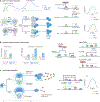Clonal haematopoiesis and dysregulation of the immune system
- PMID: 36941354
- PMCID: PMC11140722
- DOI: 10.1038/s41577-023-00843-3
Clonal haematopoiesis and dysregulation of the immune system
Abstract
Age-related diseases are frequently linked to pathological immune dysfunction, including excessive inflammation, autoreactivity and immunodeficiency. Recent analyses of human genetic data have revealed that somatic mutations and mosaic chromosomal alterations in blood cells - a condition known as clonal haematopoiesis (CH) - are associated with ageing and pathological immune dysfunction. Indeed, large-scale epidemiological studies and experimental mouse models have demonstrated that CH can promote cardiovascular disease, chronic obstructive pulmonary disease, chronic liver disease, osteoporosis and gout. The genes most frequently mutated in CH, the epigenetic regulators TET2 and DNMT3A, implicate increased chemokine expression and inflammasome hyperactivation in myeloid cells as a possible mechanistic connection between CH and age-related diseases. In addition, TET2 and DNMT3A mutations in lymphoid cells have been shown to drive methylation-dependent alterations in differentiation and function. Here we review the observational and mechanistic studies describing the connection between CH and pathological immune dysfunction, the effects of CH-associated genetic alterations on the function of myeloid and lymphoid cells, and the clinical and therapeutic implications of CH as a target for immunomodulation.
© 2023. Springer Nature Limited.
Figures



References
-
- Looker AC, Dallman PR, Carroll MD, Gunter EW & Johnson CL Prevalence of iron deficiency in the United States. Jama-Journal of the American Medical Association 277, 973–976 (1997). - PubMed
-
- Afdhal N et al. Thrombocytopenia associated with chronic liver disease. Journal of Hepatology 48, 1000–1007 (2008). - PubMed
-
- Nimer SD Myelodysplastic syndromes. Blood 111, 4841–4851 (2008). - PubMed
Publication types
MeSH terms
Substances
Grants and funding
LinkOut - more resources
Full Text Sources

